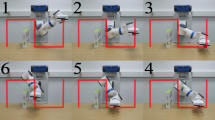Abstract
The human body can be modeled as a kinematically redundant manipulator which exploits “redundant degrees of freedom” to execute various motions in a suitable fashion. Differently from the typical kinematically redundant robots that are attached to the fixed ground, the zero moment point (ZMP) condition should be taken into account not to fall down. Thus, this paper investigates a motion planning algorithm for kinematically redundant manipulator standing on the ground. For this, a geometric constraint equation is derived from the existing ZMP equation. This constraint equation is formed like a second-order kinematic equation, which enables one to plan the ZMP trajectory in a feed-forward fashion. This constraint equation and the kinematic equation of the manipulator model are solved together. Then, the solution of this composite equation guarantees both the desired operational motion and the ZMP trajectory. The feasibility of the proposed algorithms is verified by simulating and experimenting several motions though a planar 3-DOF manipulator model.










Similar content being viewed by others
References
Nakamura Y (1991) Advanced robotics: redundancy and optimization. Addison-Wesley, New-York
Suh KC, Hollerbach JM (1987) Local versus global torque optimization of redundant manipulators. In: Proceedings of IEEE international conference on robotics and automation, pp 619–624
Chiaverini S, Oriolo G, Walker ID (2008) Handbook of robotics. Kinematically redundant manipulators. Springer, London
Siciliano B, Slotine J-JE (1997) A general framework for managing multiple tasks in highly redundant robotic systems. In: Proceeding of IEEE internal conference on advanced robotics, pp 1211–1216
Escande A, Mansard N, Wieber P-B (2014) Hierarchical quadratic programming: fast online humanoid-robot motion generation. Int J Robot Res 33(7):1006–1028
Vukobratovic M, Frank AA, Jricic D (1970) On the stability of biped locomotion. IEEE Trans Biomed Eng BME 17(1):25–36
Takanishi Q, Li A, Kato I (1993) Learning control for a biped robot with a trunk. In: Proceedings of IEEE/RSJ international conference on intelligent robots and systems, pp 1771–1777
Dasgupta A, Nakamura Y (1999) Masking feasible walking motion of humanoid robotics from human motion capture data. In: Proceedings of IEEE international conference on robotics and automation, pp 1044–1049
Park J, Kwon O (2001) Reflex control of biped robot locomotion on a slippery surface. In: Proceedings of IEEE international conference on robotics and automation, pp 4134–4139
Kurazume R, Hasegawa T, Yoneda K (2003) The sway compensation trajectory for a biped robot. In: Proceedings of the IEEE/RSJ international conference on intelligent robots and systems, pp 925–931
Chevallereau C, Abba G, Aoustin Y, Plestan F, Westervelt ER, Canudas-de-Wit C, Grizzle JW (2003) RABBIT: a testbed for advanced control theory. IEEE Control Syst Mag 23(5):57–79
Kim J, Chung W, Youm Y, Lee B (2002) Real-time ZMP compensation method using null motion for mobile manipulators. In: Proceedings of IEEE international conference on robotics and automation, pp 1967–1972
Sugihara T, Nakamura Y (2003) Contact phase invariant control for humanoid robot based on variable impedant inverted pendulum model. In: Proceedings of IEEE international conference on robotics and automation, vol. 1, IEEE, pp 51–56
Kajita S, Kanehiro F, Kaneko K, Fujiwara K, Harada K, Yokoi K, Hirukawa H (2003) Biped walking pattern generation by using preview control of zero-moment point. In: Proceedings of IEEE international conference on robotics and automation, pp 1620–1626
Suleiman W, Kanehiro F, Miura K, Yoshida E (2009) Improving ZMP-based control model using system identification techniques. In: Proceedings of IEEE/RAS international conference on humanoid robots, pp 74–80
Park JH, Rhee YK (1998) ZMP trajectory generation for reduced trunk motions of biped robots. In: Proceedings of the IEEE/RSJ international conference on intelligent robots and systems, pp 90–95
Wu H-M, Hwang C-L (2011) Trajectory-based control under ZMP constraint for the 3D biped walking via fuzzy control. In: Proceedings of IEEE international conference on fuzzy systems, pp 706–712
Kim D, Kim N-H, Park G-T (2012) ZMP based neural network inspired humanoid robot control. Nonlinear Dyn 67(1):793–806
Yoshikawa T (1985) Manipulability of robotic mechanisms. Int J Robot Res, pp 3–9
Freeman RA, Tesar D (1998) Dynamic modeling of serial and parallel mechanisms/robotic systems, part I-methodology, part II-applications. Proceedings of 20th ASME mechanisms conference 15(3):7–27
So BR, Choi JY, Yi B-J, Kim WK (2005) A new ZMP constraint equation with application to motion planning of humanoid using kinematic redundancy. In: Proceedings of the IEEE international conference on intelligent robots and system, pp 1794–1800
Sardain P, Bessonnet G (2004) Forces acting on a biped robot. Center of pressure-zero moment point. IEEE Trans Syst Man Cybernet Part A Syst Hum 34(5):630–637
Sinyukov D, Desmond R, Dickerman M, Fleming J, Schaufeld J, Padir T (2014) Multi-modal control framework for a semi-autonomous wheelchair using modular sensor designs. Intell Serv Robot 7(3):145–155
Acknowledgments
This work is supported by the Technology Innovation Program (10040097) funded by the Ministry of Trade, Industry and Energy Republic of Korea (MOTIE, Korea) and supported by Mid-career Researcher Program through NRF grant funded by the MEST (NRF-2013R1A2A2A01068814). This work performed by ICT based Medical Robotic Systems Team of Hanyang University, Department of Electronic Systems Engineering was also supported by the BK21 Plus Program funded by National Research Foundation of Korea(NRF).
Author information
Authors and Affiliations
Corresponding author
Rights and permissions
About this article
Cite this article
So, BR., Ryu, H. & Yi, BJ. ZMP-based motion planning algorithm for kinematically redundant manipulator standing on the ground. Intel Serv Robotics 8, 35–44 (2015). https://doi.org/10.1007/s11370-014-0164-8
Received:
Accepted:
Published:
Issue Date:
DOI: https://doi.org/10.1007/s11370-014-0164-8




